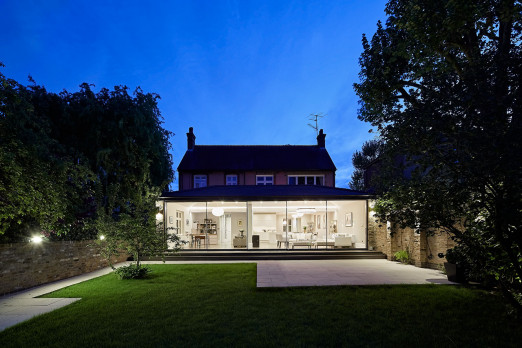The winner of the British Home Awards 'Home for Britain' competition.
Concept
Our aim was to produce a design that created a pleasing and inviting geometry and to include enough detail to engender a sense of intimacy, security and belonging.
The front of the house to be minimal in size to provide the practical and social interface with the community, allowing a larger more private and green relaxing garden to the rear with connections to the cycling and pedestrian network.
The house we have designed comprises 3 floors and maximises use of the whole structural volume of the house and incorporates the latest smart green and sustainable technologies. Our vision was to create a more romantic geometry and roofscape within a treed setting.
External Design Aesthetic
Roof Form - The arching roofs are the the dominating geometry of the house and are formed with 200mm thick curved SIP panels which sit directly on the aircrete walls and gables. The curving roof form dominates the streetscape and allows as much daylight as possible to reach street level and also allows less obstructed views of the sky. The coating is a metallic zinc, although many variations could be considered, perhaps even synthetic thatch. A metallic coating would reflect even more daylight, enhancing a brighter street environment.
Facade - The front gable features a stepped elevation that has wood clapper-board panels that subtly overhang the lower one to give an increased sense of enclosure and intimacy, reminiscent of a barn giving a rural reference in an otherwise urban environment. The other materials chosen are a white acrylic render and a small panel of handmade bricks adjacent to the front door to enhance the sense of detail, texture and warmth. Different colours of stain could be used to provide variety and individuality to homes.
Rear Elevation - The rear elevation is more simply modelled using the same materials but
with larger areas of glazing facing the garden area.
Planning & Layout
The layout of multi unit terraces are stepped at an angle to minimize the overlooking factor, as house fronts don’t look directly towards each other. It creates natural ‘nooks’ that form a natural ‘bay’ where a car, possibly a second small one can be parked. The front area to the house is further enclosed by a planter that runs parallel to the walkway to the front door and terminates with semi mature trees, one an evergreen and one deciduous to give volume and colour all year round. There is a hedge on the other side adjacent to the bin store.
The layout is based on a 5-unit terrace with a cycle path or road at each break. This allows for separate cycle and road network grids.
The angled layout of the plot readily creates bays for landscaping and tree planting opportunities along the cycleways and roads.
Design Features
• Attractive appearance.
• Appropriateness for a wide market.
• Ability to vary external appearance to adapt to different locations.
• Compliant with Lifetime Homes.
• 21st century living space – to meet changing lifestyle needs.
• Good use of space (open, adaptable, flexible, movement, access, circulation, etc)
• Indoor environment (lighting, acoustics, heating, ventilation, finishes etc)
• Smart Home integration : Intelligent infrastructure, wireless technology and cabling
• Renewable and low carbon technologies
• Security – secure by design and crime prevention measures
• Intelligent docking ports for electric vehicles, with the capability for two-way interaction
between the car’s batteries and the home energy systems.
• Innovative and inclusive bins and cycle stores
Innovative Materials & Technology
• Curved SIPS panels to form Roof. Combines structure and insulation.
• External wall insulation KNAUF. Provides thermal mass internally using thin-joint Aircrete blocks.
• State of art technology includes underfloor heating system
• Heat recovery ventilation (90% efficient) with ‘Summer bypass’ to help cooling in hotter months.
• Viessman Vitovalor 300-P domestic fuel cell mCHP boiler for decentralised domestic power generation.
• Integration with government-backed ‘Internet Of Things’ for smart-home connectivity and remote app-control by users for security, lighting and media.
• Rainwater harvesting, garden and food composting.
• Roof-mounted solar panel PV array.
Eco & Green
• Thin Joint Aircrete system to help the building achieve zero carbon emissions
• The proposal includes low energy LED lights throughout.
• All floors walls and ceilings insulated to higher than current standards.
• A Heat Recovery Ventilation (HRV) system recovers heat from extracted air and provides fresh filtered air.
• A supplementary photovoltaic roof-mounted array
Budget
The Construction cost is contained to £100 per square foot with maximum cost of £200,000
Architects: McInnes Gardner


